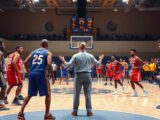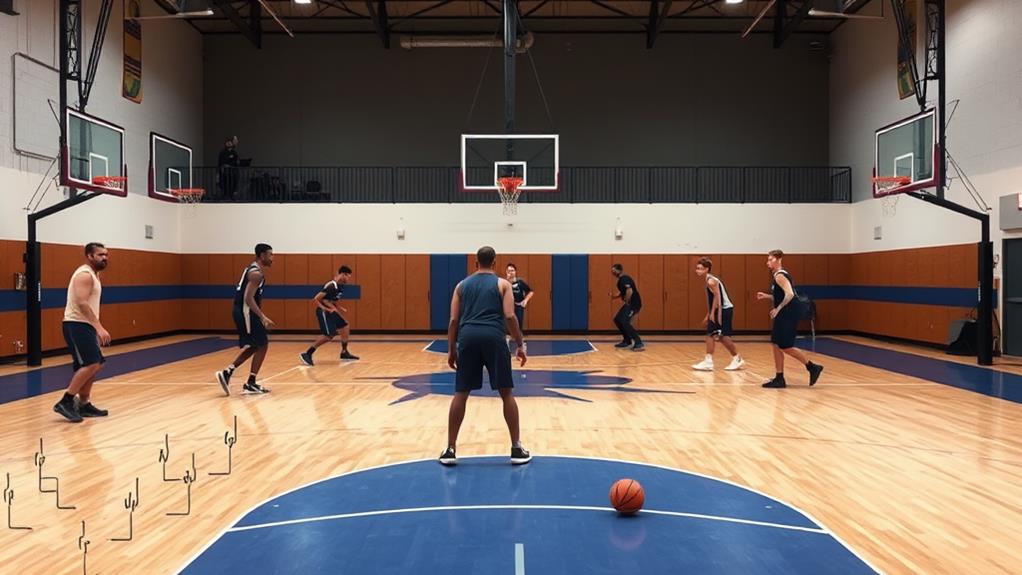
Coaching Tips for Running a 3-2 Zone Defense
September 17, 2024To effectively run a 3-2 zone defense, focus on communication and clear player roles. Position three perimeter players at the arc and two in the post to protect the paint. Encourage quick rotations and double teams to disrupt the opponent's play. Make sure your point guard directs the defense while all players use verbal and hand signals for seamless adjustments. Regular practice will enhance skills like lateral agility and anticipation, leading to better performance. If you want strategies to further sharpen your defensive tactics, there's much more to explore.
Understanding the 3-2 Zone
The 3-2 zone defense is a strategic formation that balances perimeter and interior coverage, making it effective against various offensive strategies. In this setup, you'll have three perimeter players—usually the point guard, shooting guard, and small forward—who position themselves at the top of the arc and the elbows. This allows them to contest shots and cut off driving lanes effectively.
Meanwhile, your two post players, the power forward and center, focus on protecting the paint, essential for deterring offensive penetration.
To enhance your defensive strategy, make certain that your team understands the fundamental principles of defense, such as pressure and cover, which can help disrupt the opponent's plays.
When executing the 3-2 zone in the half court, you must emphasize effective communication and quick rotations. This is crucial for maintaining coverage and adapting to the opposing team's movements. You'll want your perimeter players to be ready to double-team designated threats while making sure the interior remains solid.
Flexibility is key; positioning your players based on the offensive strengths and weaknesses can enhance the defense's effectiveness. Remember, physicality and coordination among the post players are essential to secure rebounds and control the paint.
Key Defensive Movements
Effective execution of the 3-2 zone defense relies heavily on key defensive movements that adapt to the flow of the game.
By incorporating principles from regular practice for team performance, teams can enhance their defensive coordination and communication on the court.
Here are three essential movements to focus on:
- Double Teaming: When the ball enters the designated player, initiate a double team from the point guard and shooting guard. This pressure can force a turnover, disrupting the offense's rhythm.
- Lane Coverage: The small forward needs to shift into the lane during defensive rotations. This helps cover passing lanes and prevents easy access to the basket, enhancing your defensive positioning.
- Quick Collapse: If the ball is passed to the post player, the power forward and small forward should collapse into a double team. This strategy limits scoring opportunities and maintains pressure on the offense.
Importance of Player Roles
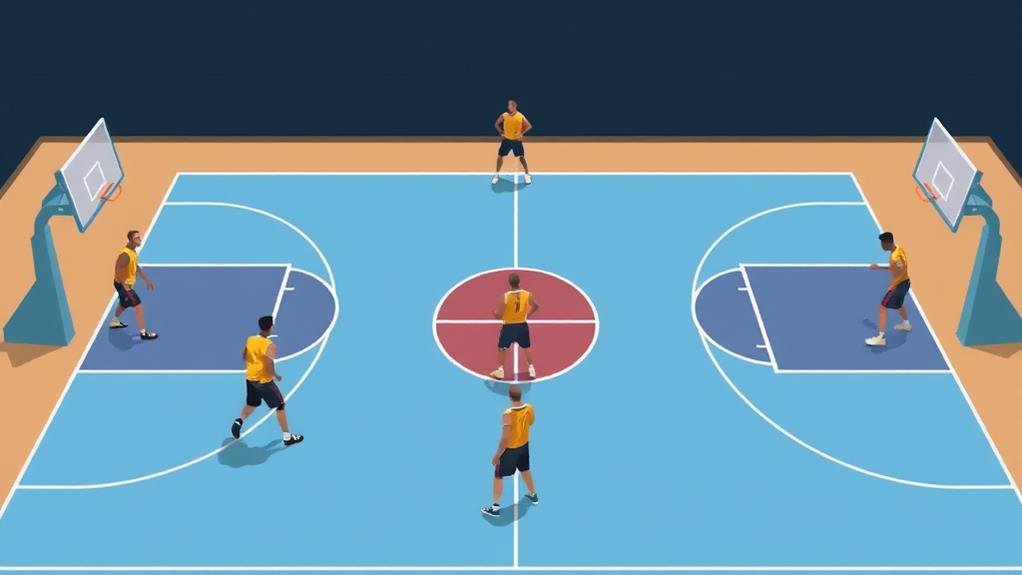
In a 3-2 zone defense, understanding your role is essential for success. Each player needs to know their specific responsibilities and communicate effectively with teammates to maintain solid coverage.
This is similar to the importance of positional awareness in soccer, as it enhances team performance and clarifies each player's duties effective communication and formations.
Coordination among players not only strengthens your defense but also helps prevent offensive scoring opportunities.
Defining Player Responsibilities
Understanding player responsibilities is essential for a successful 3-2 zone defense. Each player's role is fundamental for maintaining strong player positioning, effective defensive rotations, and applying perimeter pressure.
Here's a quick breakdown of responsibilities:
- Point Guard: Initiates the defense at the top of the arc, using speed and aggression to pressure the ball handler and disrupt the offensive flow.
- Shooting Guard & Small Forward: Must quickly close out on shooters and assist in double teams, especially when the ball is passed to the corners or wings.
- Power Forward & Center: Focus on guarding the post, communicating effectively to switch or double team when the ball enters the paint.
Each player needs to understand their specific role within the 3-2 zone. The point guard and shooting guard emphasize perimeter defense, while the post players work to deter inside penetration.
Consistent communication among all players is essential to maintain lane coverage, ensuring everyone is ready to adapt during offensive shifts. By clearly defining these player responsibilities, your team can execute a cohesive and effective 3-2 zone defense.
Communication and Coordination
Communication and coordination are the lifeblood of a successful 3-2 zone defense. Without these elements, your team struggles to adapt to offensive movements, leading to breakdowns in coverage. The point guard plays a vital role here, needing to lead the defense by calling out plays and directing teammates. This establishes command and guarantees everyone understands their roles during defensive shifts and rotations.
Small forwards and shooting guards must maintain constant verbal cues and non-verbal signals to coordinate effective double teams and fill lanes promptly. Their ability to communicate helps create team synergy, making it easier to anticipate the offense's next move.
Post players, including the power forward and center, must also consistently communicate to manage their responsibilities and provide help defense against penetration.
To enhance your 3-2 zone defense, incorporate regular practice drills that emphasize communication and coordination. These drills will enable your players to develop a better understanding of each other's movements, allowing for seamless adjustments during games.
When your team masters the art of communication, they'll become a formidable force on the court, making it tough for opponents to break down your defense.
Effective Communication Strategies
Effective communication is essential for executing a successful 3-2 zone defense. Without clear signals and trust among players, defensive assignments can quickly fall apart.
In soccer, similar principles apply when coordinating strategies, as highlighted in soccer moves guide for enhancing team dynamics. Here are three key strategies to enhance your team's communication:
- Establish Verbal Cues: Create a set of specific verbal signals for defensive rotations and double teams. Everyone should know when to switch responsibilities, guaranteeing seamless shifts.
- Utilize Hand Signals: Implement a system for silent communication using hand signals. This is vital during high-pressure situations where shouting can lead to confusion. Players should practice these signals regularly to confirm everyone's on the same page.
- Foster Team Trust: Build an environment where players feel comfortable giving feedback. Encourage them to call out the ball's location and the number of passes. This not only enhances awareness but also strengthens team trust, allowing players to hold each other accountable.
Adjusting to Offensive Plays
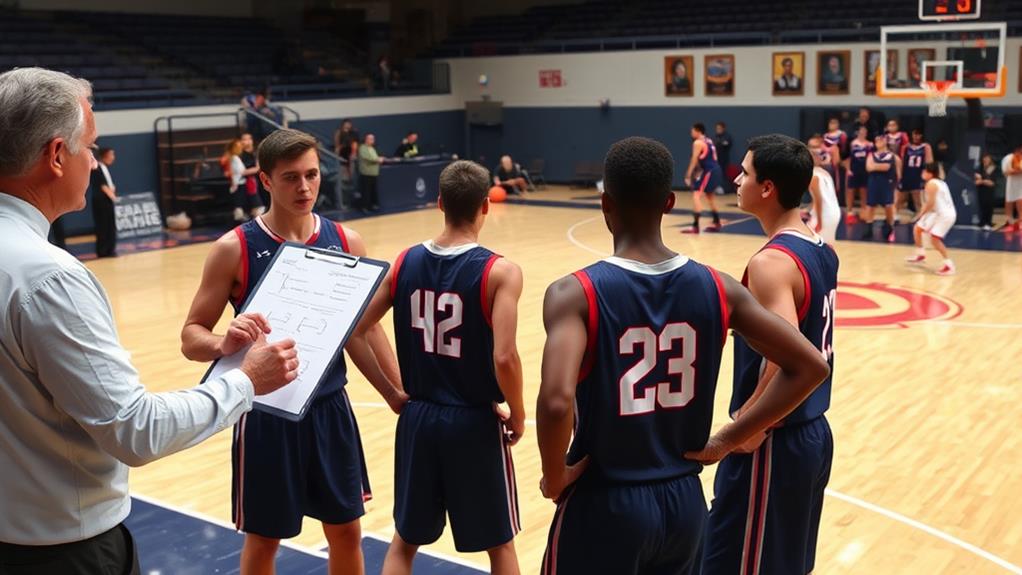
Adjusting to offensive plays requires quick thinking and adaptability from your team. When you face fast-paced offenses, make certain your point guard is always ready to intercept passes and initiate defensive shifts. This helps maintain lane coverage and disrupts the opposing team's offensive strategies.
If they frequently use pick-and-roll plays, have your small forward and power forward practice switching on screens. This will effectively tackle player mismatches and keep your defense intact. In addition, a strong understanding of event rules can provide your team a strategic advantage, allowing for better anticipation of the opponents' movements.
Encourage your players to communicate consistently, recognizing when to double-team the designated offensive player. This way, your small forward can fill the lane, preventing easy shots and maintaining pressure.
Moreover, adjust your defensive formation on the fly: have the shooting guard and small forward close out aggressively on shooters while your post players stay alert for potential penetration.
Regularly evaluate and adapt your defensive rotations based on the offensive sets used by the opposing team. By implementing these counter tactics, you can maintain a strong defensive presence and minimize open shot opportunities, keeping your team in the game and ready to respond to any offensive challenge.
Practicing Defensive Skills
To effectively practice defensive skills, you need to drill footwork that enhances agility and quickness on the court.
Incorporating drills that focus on mastering interception and anticipation can greatly improve your team's ability to disrupt opponent passing strategies.
Improving communication among your players is essential, as it helps them react better during games.
Emphasizing quick reactions will guarantee your team can respond promptly to offensive plays and maintain a solid defensive stance.
Drill Defensive Footwork
Mastering defensive footwork is essential for any player looking to excel in a 3-2 zone defense. Strong footwork not only helps you stay balanced, but it also enhances your reaction time, enabling quick shifts in weight and direction.
Here are three key aspects to focus on:
- Low Defensive Stance: Always maintain a low defensive stance to improve balance. This position allows you to react swiftly to offensive movements.
- Lateral Movement Drills: Incorporate slide and shuffle drills to boost your lateral agility. These drills help you stay in front of opponents while ensuring proper spacing in the zone.
- Quick Footwork: Practice short, quick steps during defensive slides. This technique prevents overcommitting to one side, reducing openings in your defense.
Don't forget to include closeout drills, which teach you to close the distance to a shooter while maintaining your defensive posture.
Mirror drills are also effective, as they reinforce the connection with the offensive player while keeping your own positioning in check.
Improve Communication Skills
During practice, effective communication is essential for executing a successful 3-2 zone defense. Establish clear verbal cues for defensive rotations, so all players can quickly identify when to shift or double team. This enhances overall responsiveness on the court.
Implement regular communication drills, focusing on calling out screens, switches, and player assignments. This builds familiarity and trust among teammates.
Encourage players to maintain eye contact and use hand signals to convey information without disrupting the game's flow, especially when noise levels rise. This non-verbal communication can be a game-changer during intense moments.
Consider conducting video analysis sessions where players can observe their communication patterns in-game. This practice allows them to identify areas for improvement and collaboratively develop their defensive skills.
Lastly, foster an accountability culture by having players discuss defensive breakdowns post-game. Emphasize how communication can prevent easy scoring opportunities for opponents.
Emphasize Quick Reactions
Quick reactions are essential for players in a 3-2 zone defense, as they can make the difference between allowing an open shot and forcing a turnover.
To enhance your team's defensive skills, focus on these key areas:
- Lateral Agility Drills: Incorporate drills that emphasize quick lateral movements, allowing perimeter players to close out effectively on shooters.
- Reaction Time Exercises: Use drills that require players to respond to a coach's signal, sharpening their ability to assess and adjust their positioning quickly.
- Small-Sided Games: Create game-like scenarios where players can practice decision-making and defensive adjustments under pressure.
Evaluating Defensive Performance
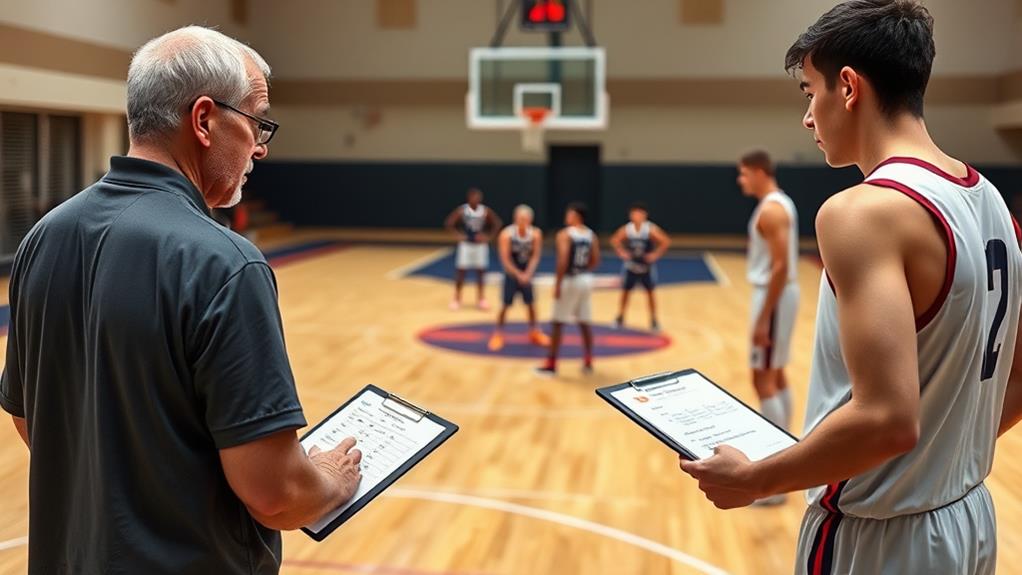
To effectively gauge the performance of your 3-2 zone defense, you'll want to dig into several key metrics that reveal both strengths and weaknesses.
Start with open shot analysis; regularly track the number of open shots allowed to identify issues in your rotations and positioning. Understanding the importance of field dimensions and equipment requirements can also help guarantee your players are adequately prepared for their defensive roles. If players are consistently giving up open looks, it's time to reassess your defensive schemes and communication.
Next, focus on turnover metrics. Analyze the effectiveness of any double teams by measuring the percentage of turnovers generated versus fouls committed. This will help you understand if your players are making smart decisions under pressure.
Don't overlook rebounding strategies, either. Aim for securing at least 75% of available defensive rebounds to limit second-chance opportunities for the opposing team.
Evaluating your team's success in this area can greatly impact your overall defensive performance.
Conclusion
Incorporating these coaching tips will help your team master the 3-2 zone defense, transforming them into a well-oiled machine on the court. Just like a sturdy wall protects a fortress, your players will shield the basket from offensive attacks. By understanding their roles, communicating effectively, and adjusting to opponents, they'll create a dynamic defense that's tough to crack. With consistent practice and evaluation, your team will become a formidable force, ready to take on any challenge.

